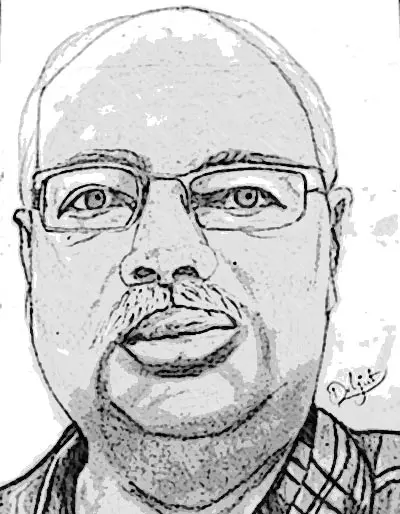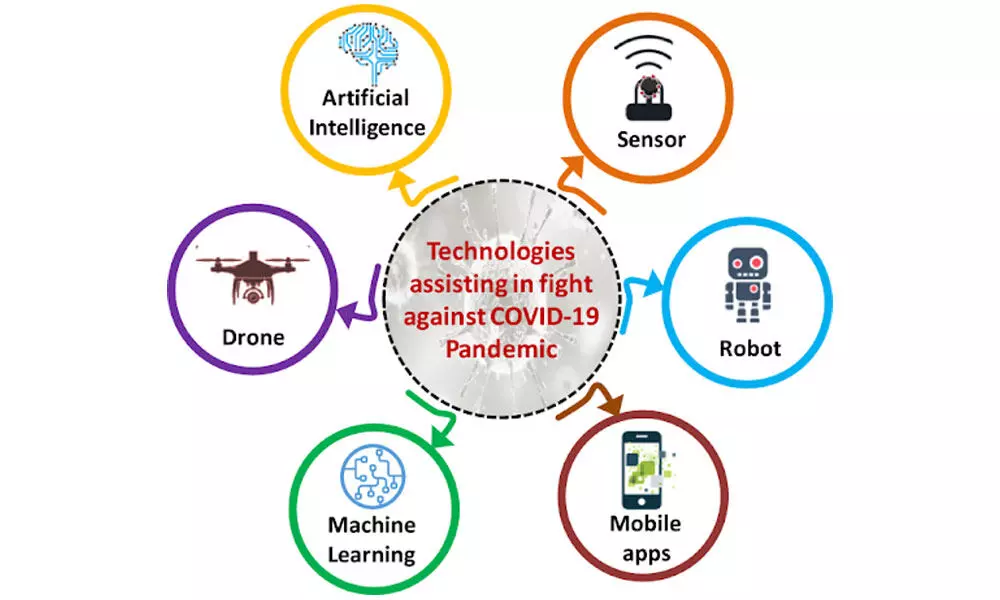Live
- Mohan Babu should immediately issue a public apology: Press Club President Balavardhan
- Strict Protocols Set for Group 2 Exams in Wanaparthy District
- Delhi Police busts gang involved in cable theft on Delhi Metro Blue Line
- MP's Gita recitation programme finds place in Guinness World Records
- Pawan Kalyan Shines Globally as 2nd Most Googled Actor of 2024 Amid Busy Film, Political Career
- Disruptor of House is the chairman himself: Cong and INDIA bloc’s pointed remarks on No-trust notice
- IIIT-Bangalore to host computer vision conference ICVGIP 2024
- F1: Fernando Alonso ‘still dreaming’ of third world championship
- WI vs Bangladesh Watch Controversial Banter Between Shakib and King
- EFLU Celebrates Bharatiya Bhasha Diwas
Just In
Harnessing technology to tackle Covid 2.0


Harnessing technology to tackle Covid 2.0
First wave of the novel coronavirus took the globe by shock and surprise and pushed the world into a depressing situation
First wave of the novel coronavirus took the globe by shock and surprise and pushed the world into a depressing situation.
The governments had no clue on how to handle the situation. It was pure trial and error method of treatment and the Centre and States depended more on manual system of tracing and testing methods followed by certain measures like national lockdown which helped in breaking the chain and gaining control over the situation.
Though the country is in midst of second wave, still it appears that not enough focus is being laid in using technology to its optimum level. The tools that were introduced during the first wave helped in analysing the Covid-19 cases and distribution of ration etc. The Aarogya Setu app which is an Indian Covid–19 app helped in "contact tracing, syndromic mapping and self-assessment" and the app reached more than 100 million installs in 40 days.
The purpose of this app was to spread awareness of Covid-19 and to connect essential Covid-19 related health services to the people of India. It augmented the initiatives of the Health department to contain the virus and share best practices and advisories using the smartphone's GPS and Bluetooth features to track the Coronavirus. It is meant to determine the risk if one has been near (within six feet of) a Covid-19 -infected person, by scanning through a database of known cases across India.
The state governments used technology to communicate with the Union government and interact with the officers and public representatives at the district and mandal level.
Drones were used to spray disinfectants in districts and this helped the government in preventing the spread of the virus to some extent in rural areas. The drones helped police officials in crowd management during the lockdown. Usage of technology has not only solved problems but has created new opportunities in the State.
At a time when most news coverage is centred around inaccessibility of oxygen, shortage of injections like Remdesivir due to production limitations and perhaps lack of timely planning by respective State governments, shortage of beds, growing number of Covid-19 deaths etc, it would be interesting to see how technology can be used to overcome the logistical challenges and physically delivering the vaccine.
This becomes all the more important since the Centre had decided all those who are above 18 should get vaccinated from May 1. This has led to all state governments sending SoS to the Centre saying that they cannot implement it at least till August as there were no adequate quantities of vaccine available.
The Telangana government which has been ahead of other States in giving a boost to technology is planning to use drones for distribution of vaccine. It has obtained necessary permissions from Director General Civil Aviation and ICMR. In the backdrop of this latest development, it would be interesting to see how drones can be helpful in vaccine distribution.
The drones will help in limiting human exposure to Covid congested or Covid-prone areas through aerial delivery. They will ensure access to health care to the last mile, especially in remote areas; possible integration into the middle mile of medical logistics for long-range drones; and improving the medical supply chain, especially with a third vaccine expected to be commissioned and millions of doses to be transported across India.
Since Covid-19 vaccine needs to be delivered using cooler boxes, these drones will have to be equipped with heavy lift capacity and heavy vaccine cooler box. Drones have been playing a critical role in the fight against the Covid-19 pandemic: delivering vaccines to communities that need them the most in other parts of the globe.
Since late 2018, countries have started deploying drones to deliver vaccines. According to information available,small Pacific island nation of Vanuatu was the first one to do it. In 2019, Ghana started off one of the largest drone delivery vaccine networks in the world.
The service, reports say they operate 24x7 with a force of 30 drones serving nearly 12 million people of the country. During the Covid-19 crisis, drones also carried testing kits across Ghana. In Rwanda, drones are supplying blood and medical supplies to several locations across the country. At present, drones carry more than 35 per cent of Rwanda's national blood transfusion service supply through a network of 21 remotely located clinics.
There are instances of drone usage in emergency situations in India as well. The National Disaster Management Authority (NDMA) used drones during the Uttarakhand floods in 2013, and again during Kerala floods in 2018. In 2019, during the forest fires at Bandipur in Karnataka, the Forest department administered drones to tackle the situation.
In September 2019, the Maharashtra government and Zipline, a drone delivery service, "announced a partnership to use a logistics network of autonomous delivery drones to help transform emergency medicine and critical care". Similarly, the Drone Application and Research Centre (DARC) of Uttarakhand recently conducted successful trials to deliver vaccines in remote areas. The State government is also planning to collaborate with private players to expand the scope of the project.
So far so good but, the Centre and state governments do not seem to be utilising the digital platforms for dissemination of accurate information pertaining to the Covid-19. While 167 countries out of 193 which are member states of United Nations had provided information pertaining to outbreak of cases, travel restrictions, practical guidance on how to protect from the virus, governmental responses etc on their national portals, mobile apps or through social media, we in India failed to make that kind of use of technology.
India has however successfully utilised online platforms for providing opportunity to all those in IT sector to work from home for almost past one year. This technology also helped in connecting millions of students and workers to their schools and offices which helped in containing the spread of Coronavirus to a great extent.
Educators embraced online learning and held live-streaming of classes through digital platforms like Zoom, Google Hangouts, and Microsoft Teams. With the governments yet to come to grips in containing the second wave and with alerts of a third wave towards end of 2021, the use of digital platforms is likely to continue and even schools may decide to continue with online classes.
Though there are many other possibilities where technology can be well used during the pandemic time, somehow, we in India seem to be lagging behind in this direction.
In South Korea, artificial intelligence is used for diagnosis and assessment of virus symptoms. The software developed by them can detect, segment and produce 3D models of lung damage caused by Covid-19 based on analysis of CT images. They also use mobile technology for contract tracing so that understanding the spread of the virus and its management becomes much easy.
Its time the political executive of the country both at the Centre and in States focuses its attention on making best to use the technology and put political considerations and rhetoric on the back burner. They should zoom ahead in making maximum use of technology and show guts to come out with real time real data on Covid-19 management.
The way things are moving at present, it appears that the Centre and States have landed in a terrible mess with regard to supply of vaccine. While the Centre remained silent on dual pricing, states like Telangana have withdrawn supply of vaccine to private hospitals. Such policies are bound to create greater problems and result in bigger mess in handling Covid-19 situation.
If the Centre had continued with its decision to buy entire stock of vaccine produced in India and continued with the responsibility to supply to States, may be, such confusion would not have arisen. Technology could have been used to streamline the supply chain, but political considerations seem to be making the rulers blindfold to reality.

© 2024 Hyderabad Media House Limited/The Hans India. All rights reserved. Powered by hocalwire.com






